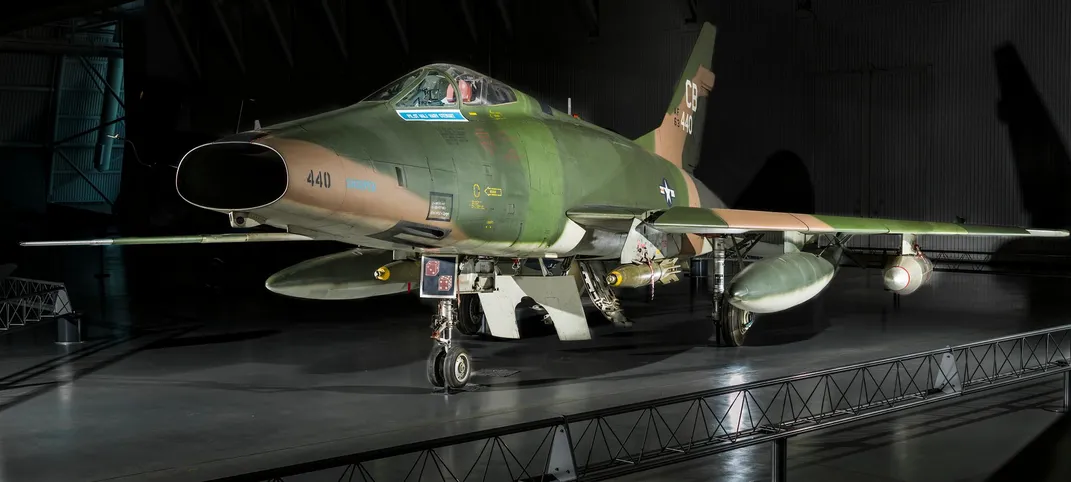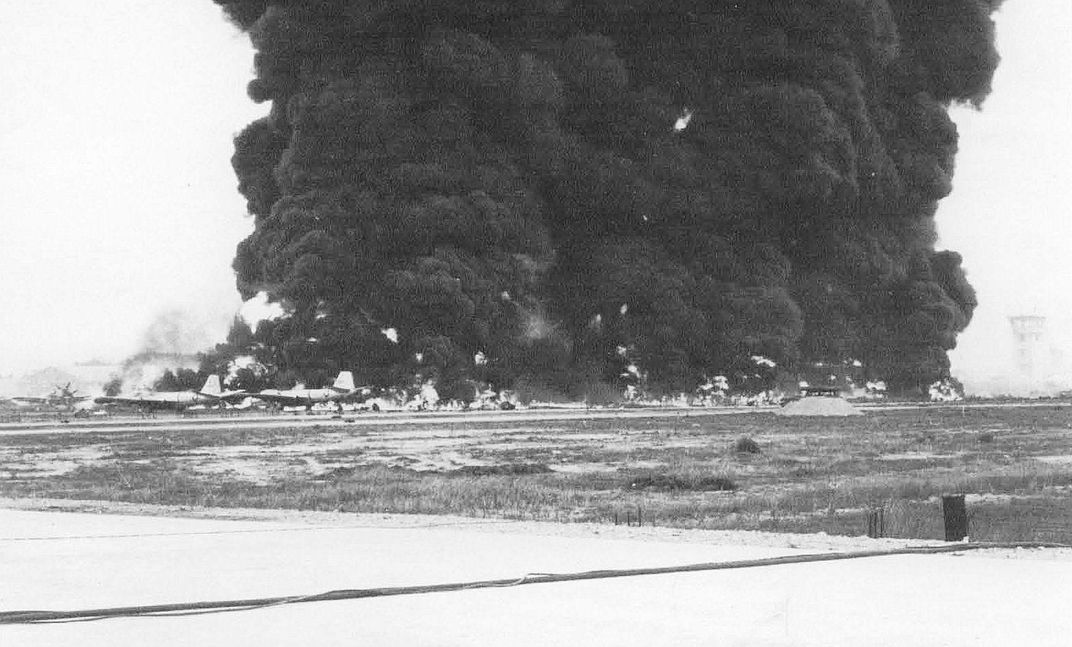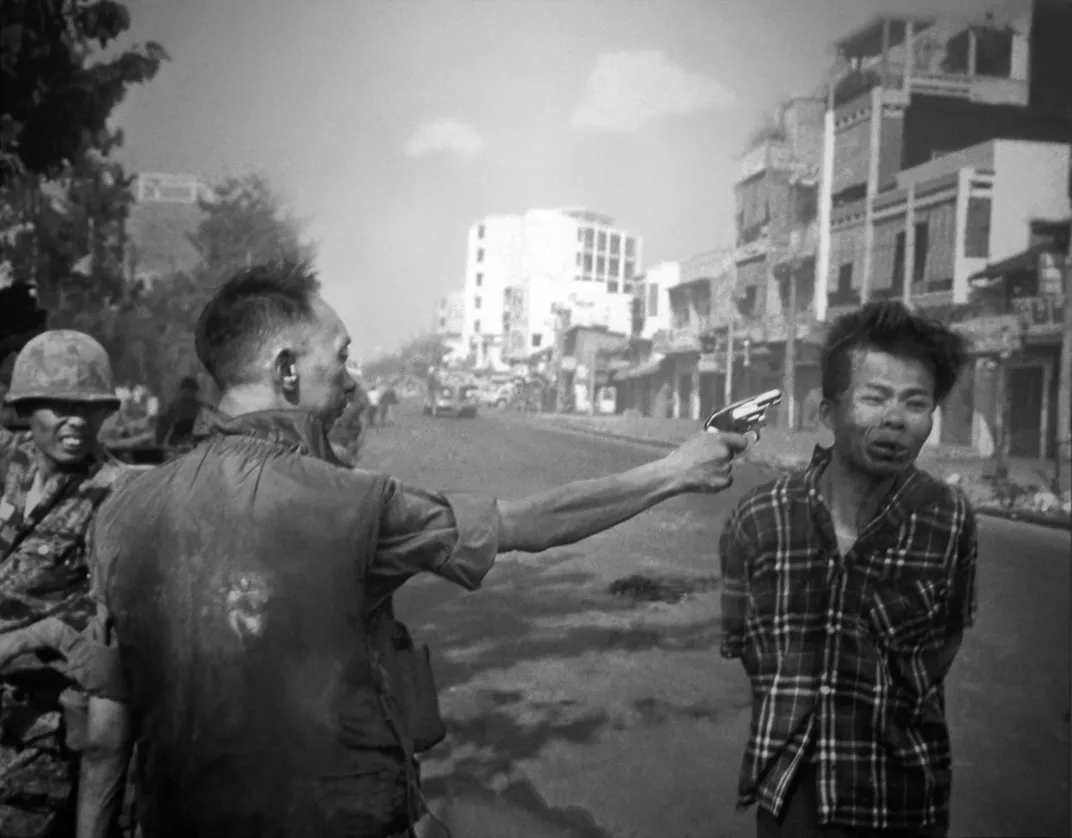This Fighter Jet Turned the Tide During Vietnam’s Decisive Tet Offensive
More than five decades ago, America won this huge battle, but lost the war
/https://tf-cmsv2-smithsonianmag-media.s3.amazonaws.com/filer/74/6c/746c9f63-cdd8-4d4f-95c1-edd321410645/352d_tactical_fighter_squadron_-_f-100_super_sabre.jpg)
Plunging to make a Mekong Delta strafing run, the pilot of a North American F-100D Super Sabre realized he had waited too long to pull out of his dive. He saw only one possible escape route, and he took it. By dangerously driving his Super Sabre up through the trees, he survived to face the enemy again.
While the pilot’s name is unknown, his plane, still in wartime camouflage, resides in the collections of the Smithsonian’s National Air and Space Museum and is on view at the Udvar-Hazy Center in Chantilly, Virginia. The account of the flight, recorded for history, can be found in the curatorial files. This aircraft sliced through the skies over Vietnam from 1965 to 1970. But its most memorable service came more than five decades ago this month, during the Tet New Year’s holiday, when a fierce North Vietnamese and Viet Cong onslaught began against American-held bases in South Vietnam.
Today, American historians still analyze Tet, even as the Socialist Republic of Viet Nam Government Portal would rather forget—no mention on the country's official history webpage can be found of the devastating loss the Viet Cong suffered during Tet.
The Tet offensive began January 30, 1968, when coordinated raids pounded every major U.S. air base and 64 South Vietnamese district capitals. The Smithsonian’s airplane “flew almost daily against Viet Cong throughout the Tet Offensive,” reports curator of aeronautics Larry Burke. Enemy fire hammered it six times in Vietnam. Each time, the warhorse returned to combat an often-unseen enemy lurking somewhere below. F-100Ds were “used constantly throughout the period of the Tet Offensive,” says Burke.
Originally envisioned as tactical nuclear fighter jets, the F-100s apparently never carried real nuclear weapons, although they did sometimes maintain alert status on the ground in Europe and the Far East with a nuclear weapon aboard. The aircraft became the first jets used in Southeast Asia that wore the colors of the U.S. military. The “Huns,” as they were commonly known, flew more sorties than any aircraft during the war, with F-100Cs, F-100Ds and F-100Fs serving there. They were valuable and busy representatives of American air power.

Initially, military leaders were unsure how to use the nation’s first supersonic fighter in an essentially land-based conflict. Super Sabres lacked the maneuverability to challenge North Vietnam’s latest MiG fighters. “After early failures in the bomber escort role, they transitioned to strictly ground-attack role,” says Burke. The plane’s manufacturer, North American, also equipped the Smithsonian’s F-100D and more than 100 others with a never-used capacity straight out of science fiction: With the attachment of a rocket, it could take off without a runway.
“We never thought we’d be doing air-to-ground in a stinking Southeast Asia backwater,” a retired Air Force colonel recalled. “We never thought our ‘silver bullet’ of a fighter would eventually be painted the green-brown color of the Vietnamese swamp.” Despite their stylishly elegant, swept-back wings and their ability to exceed 800 miles per hour, F-100Ds routinely handled Vietnam air-to-ground missions, striking the enemy with bullets, bombs, rockets and napalm.
Although there were no soaring dogfights for F-100s, a nostalgic former pilot claimed that flying an F-100 was “more fun than sex.” In wartime, however, that feeling was evanescent.

The unexpected and ferocious Tet Offensive jolted American and South Vietnamese troops with blows that were bold, breathtaking and unexpectedly systematized. Beginning when many South Vietnamese soldiers were enjoying holiday leave, the widespread surprise attacks represented what author Mark Bowden calls “a masterpiece of clandestine effort.” While surreptitiously transporting personnel and supplies into South Vietnam, North Vietnamese strategists tried to anticipate every detail in planning an operation with many fighting fronts.
At Tet’s start, Viet Cong units charged Biên Hòa Air Base, home to the Smithsonian’s F100-D. In less than a day, joint efforts on land and in the air defeated the attackers. Among more than 100 Tet strikes, three—Saigon, Huế, and Khe Sanh—captured the global spotlight.
In Saigon, with a population of more than 2 million, the city had long been isolated from the war’s dangers, but Viet Cong guerillas infiltrated the U.S. embassy compound around 2:45 a.m. January 31 and held it for more than six hours.
Erroneous reports that the raiders had penetrated the embassy itself alarmed Americans back home. Insurgents also captured the government radio station but were unable to broadcast a message. They briefly captured several Saigon sites, but U.S. and South Vietnamese soldiers killed or captured all commandos within a few days. A flaw in North Vietnam’s strategy became clear: Planners had wrongly assumed South Vietnamese troops and civilians would support the initial fighters. Without South Vietnamese reinforcements, the assaults crumpled.
Pulitzer Prize winner Frances Fitzgerald, who authored Fire in the Lake: The Vietnamese and the Americans in Vietnam, describes the person-on-the-street’s response to the ramping up of U.S. military action in Saigon: “Crowds of civilians, panicked by the troops and the bombers, flooded through the streets carrying their dead and wounded with them on bicycles and pedicabs.”
Like Saigon, Huế had long been a haven from war. At least 8,000 Communist troops quickly captured the city as Tet began, controlling everything except the South Vietnamese Army’s 1st Infantry Division headquarters and a U.S. Military Assistance Command compound. Soldiers at both sites held their ground but could accomplish nothing more. Called to the scene, U.S. Marines and South Vietnamese troops fought for 25 days before recapturing the city March 2 after grueling combat that was often house-to-house and sometimes hand-to-hand.
To some Vietnamese, horror came from the skies and the U.S. planes that filled them. “These several days the airplanes flying over the city are countless. . . we can see jets flying swiftly like lightning and dropping load after load of bombs, followed by the sounds of explosions, which even though reverberating from far away are still endlessly terrifying,” wrote author Nha Ca.
The so-called “siege” at Khe Sanh began days before Tet. It was not a true siege because aircraft delivered fresh supplies and reinforcements throughout the standoff. North Vietnamese soldiers encircled the hilltop base, but they could not sever its aerial supply line. Instead, U.S. air strikes and ground-based artillery salvos pummeled them. On February 29, South Vietnamese rangers beat back the enemy, ending the last major Communist assault. In April, Marines pushed out of the base and concluded the fighting. Despite the high cost of the 77-day battle, U.S. Marines abandoned Khe Sanh three months later.
Tet captivated the media. A new satellite over the Pacific permitted Americans to see for the first time coverage of the fighting. Lyndon Johnson believed the media’s breathless reports made Americans feel defeated. The most dramatic reports aired February 27 when Walter Cronkite, the highly respected CBS anchorman declared that the nation was “mired in stalemate” and should negotiate to end the war.

The memorable image that perhaps troubled Americans the most was the gruesome photograph of Nguyen Ngoc Loan, South Vietnam’s national police chief, shooting a civilian in the head. The brutal act of the South Vietnamese official raised questions in American minds about the nation’s ally. For viewers the still-horrid scene lacked context. It was a climate of savagery. More than 2,000 civilians died in Huế, where the Viet Cong executed suspected government backers. Weeks later, U.S. soldiers killed more than 500 civilians in My Lai. Furthermore, Loan viewed Nguyen Van Lem not as a nameless civilian but as a Viet Cong “revenge squad” member. (After the war, the one-time police chief settled in suburban Washington, where he was known as a pizza parlor owner, not a villain.)
One U.S. military statement also turned into an embedded Tet memory for many Americans. “It became necessary to destroy the town to save it,” an American major said, as he spelled out the oxymoronic logic that defined so much of the American role in Vietnam.
Within a few weeks, the territorial gains of Communist forces during Tet had evaporated, but there was nothing fleeting about the human cost—for either side. In the offensive’s first two weeks, the U.S. estimated that 33,249 Communist fighters had been killed. For the same period, U.S. and allied deaths reportedly totaled 3,470, about one-third American. By March’s end, U.S. officials reported American deaths of nearly 4,000, with the opposing side losing a probably inflated number—58,000. About 14,300 civilians also died.
Tet decimated the Viet Cong, but it had a more meaningful outcome: declining U.S. support for Johnson’s handling of the war. LBJ and General William Westmoreland, U.S. commander in Vietnam, had assured Americans in 1967 that the United States was thrashing a weakening enemy. Through their fierce aggression during Tet, Viet Cong and North Vietnamese soldiers had widened a pre-existing credibility gap between LBJ and the American people—and they had accomplished that without gaining one square inch of territory.
A February Gallup Poll showed that just 35 percent of Americans backed Johnson’s war leadership. Paul Warnke, head of the Pentagon’s Office of International Security Affairs, reported in 1967 that “a year later we would be exactly where we were then, except another 10,000 Americans would have been killed.” After Tet, Johnson sought advice from a group of non-governmental foreign affairs advisers, and the so-called “wise men” delivered the same assessment: There was no light at the end of the tunnel. What the United States faced was a bottomless pit—a stalemate that could not be broken without widening the war or negotiating a peaceful settlement.
The Socialist Republic of Viet Nam Government Portal website offers no details of the Tet Offensive and while celebrating “the historic Ho Chi Minh Operation in 1975,” it wipes from history the hundreds of thousands who died throughout the war. Clearly, Tet’s impact created stronger tremors in the United States than for the already-battle-weary Vietnam. For the Communists of both Vietnams, it was a short-term loss and a long-term victory.
The U.S. war machine, which included the Air Force’s F-100Ds, had won on the streets and in the countryside of South Vietnam, but Johnson had lost in American living rooms. Tet’s chaos and almost-unimaginable violence reduced faith in the possibility of U.S. victory, leading Johnson to withdraw from the 1968 presidential race and launch peace efforts exactly two months after Tet had begun.
/https://tf-cmsv2-smithsonianmag-media.s3.amazonaws.com/accounts/headshot/Alice_George_final_web_thumbnail.png)


/https://tf-cmsv2-smithsonianmag-media.s3.amazonaws.com/accounts/headshot/Alice_George_final_web_thumbnail.png)